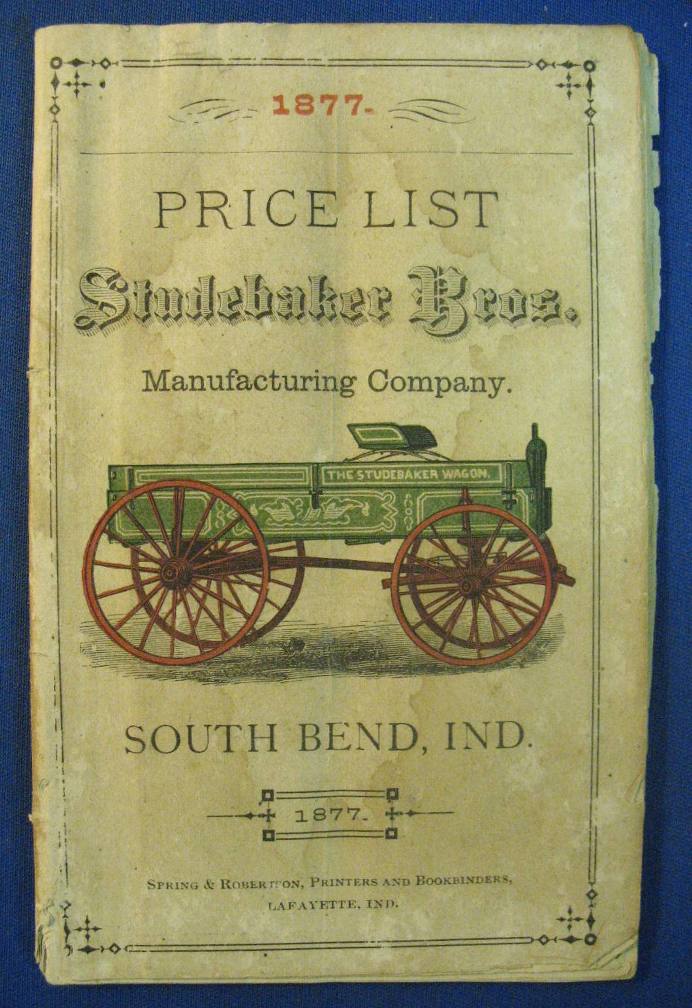I came across this great little pamphlet yesterday in the Burwell Benson Papers (Collection #60-z, finding aid). It’s an 1877 catalog of “farm, freight, plantation, platform & spring wagons” from the Studebaker Brothers Manufacturing Company of South Bend, Indiana – the same Studebaker famous for producing those swank early 20th-century (horse-less) automobiles.
The catalog includes wonderful pictures of the 1877 models (with such names as: “Salt Lake Wagons” or “Pic Nic Wagons”), a nice pullout engraving showing the South Bend factory, a page extolling the virtues of The Studebaker Slope Shoulder Spoke (“the most solid and strongest wheel yet invented”), and price lists for wagon upgrades (like “seats” or “brakes”). Finally, the catalog includes a list of the “Eleven Reasons Why Everybody Should Buy the Studebaker Wagon.” Here are some highlights from those reasons:
First: It is made of the best selected INDIANA TIMBER, the same being cut at the proper season of the year, piled under sheds, properly dated, and allowed to remain there from three to five years.
…
Sixth: It is the only wagon in which the SLOPE-SHOULDER SPOKE is used. hence they have the best wheel, which is actually the foundation of the wagon, and should be carefully examined by persons purchasing.
…
 Ninth: The Studebaker Brothers are practical workmen, attend to their business personally, and do not intrust it to the Foreman, as is generally the case in large factories, hence the superiority of their work over all others.
Ninth: The Studebaker Brothers are practical workmen, attend to their business personally, and do not intrust it to the Foreman, as is generally the case in large factories, hence the superiority of their work over all others.
[Thought I’d just throw in a picture of their sleigh selection, for good measure. If you had some dashing to do in the snow in 1877, it looks like it would have only cost you $57.50 to get outfitted with one of these beauties.]


I have a set of Studebaker running gears. There is still some paint con the wheels and under structure. It seems to be like a dark orange or brunt orange. Am trying to get back in it’s original shape and color. Can you give me any idea what color it may have been. It wasn’t red.
Thank you
Question? How can one identify a studebaker wagon?
thank you,
David Currey
Dear Vern and David,
I found an interesting website you may be interested in. It gives a good bit of detail about old Studebaker wagons:
http://www.wheelsthatwonthewest.com/Pages/FAQ.html
You may try to contact the web admin, as it looks like they would be much more knowledgeable than I.
Thanks for the comments!
I have a very bare Studebaker 67770. Is there a picture of what it originally looked like?
If anybody knows if a 1897 Studebaker Bros. Mfg. Co. Catalogue No. 101 Business Wagons is worth anything, can you e-mail me and let me know where I would find out and where I could sell it at. Thanks
Some brochures from this era sell for 35 to 50 dollars. I have 6 poster stamps for Studebaker I paid less than 25.00 for all. I would be interested in your brochure for 40.00. Text 419 908 5348 if interested.
In the early 1980 I was introduced to an old man (?Walt Bean???) who’d been a ‘real’ teamster, that is a guy that made a living hauling things with teams of horses. He had a Studebaker wagon he kept up on blocks in his front yard. He was very proud of that. (I can’t recall whether it was one with wheels or runners for the snow.) Prior to meeting him, I’d only know of the cars and trucks Studebaker had made and lacked any notion they’d started earlier, making wagons.
He lived and worked in Houghton (Northern Michigan) a place thriving owing to copper mining in his day. That’s a place with surprisingly steep hills, some brutal weather, and loads of snow. He often spoke about managing heavy loads with horse drawn sleds in the winter. He also told me that most teamsters played the harmonica as a means of entertaining themselves on long delivery routes.
Sometimes I think of the prospect of playing the harmonica and framing a melody in synch with the rhythm of horse hooves.